Faculty show leadership, courage in planning for fall semester
UND faculty play key role in molding a COVID-resilient campus

Summer – that typical lull between semesters when, around the nation, scores of university professors and instructors pursue research and creative projects outside of their institutions – has been drastically changed this year.
At the University of North Dakota, in the span of mere weeks, hundreds of faculty members have brainstormed, discussed, drafted, upgraded, proposed and adopted multifaceted arrangements for reopening campus in fall.
“The faculty have been the key players” in developing the University’s COVID-19 reopening plan, said Ryan Zerr, mathematics professor and chair of Theatre Arts. “The amount of time and the background work that they’re doing to vet ideas and test out strategies has been pretty phenomenal. They’ve been working feverishly all summer.”
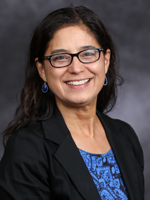
The collaboration between UND faculty and administrators (along with staff and students) in the establishment of a hybrid educational model for fall, when students will return to the classroom, is a crucial part of what the University is all about, said Debbie Storrs, interim provost and vice president for academic affairs.
The value and tenet of shared governance at the University is “the broader reason for why faculty input is so important,” she said.
But the health crisis, which has upended daily life, has created a further imperative for soliciting faculty’s help in envisioning what UND will look like when in-person classes resume in a modified form.
“Without faculty, we wouldn’t have instruction; we wouldn’t have great research and creative activity,” said Storrs. “We have to engage faculty and make sure faculty feel comfortable with the decisions that are being made about classes. We’re giving faculty a lot of autonomy in making those decisions, having conversations with their chairs and understanding what’s happening in terms of heightening safety features for them. Ultimately, faculty have to decide their comfort level with teaching in the classroom.”

With that premise in mind, the University Senate, UND’s legislative body, began facilitating discussions between faculty and administrators early on, back when fears of the virus mixed with concerns about a major spring flood in Grand Forks.
“From the beginning, the faculty in some way have been involved,” said Jeff VanLooy, outgoing University Senate president and associate professor in Earth System Science & Policy.
Aside from the Senate executive committee, made of faculty, staff and student leaders, several working groups, with similarly diverse representation of campus stakeholders, have sprung out over the last several month. From face coverings to teaching adaptations, these groups have raised faculty’s collective voice to the attention of the administration, VanLooy said.
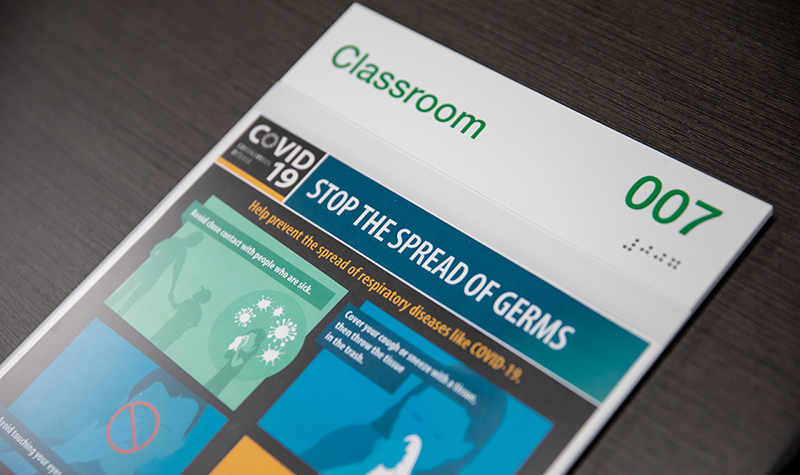
Courage and creativity in planning for fall
And, within schools, colleges and departments, faculty have continued to collaborate with chairs and deans to shape the fall semester.
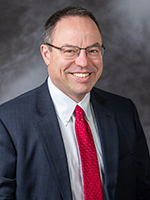
At the School of Law, for instance, Dean Mike McGinniss began convening with faculty to plan for the fall even before the spring semester had ended. He established a schedule to hold faculty discussions on Zoom every other week at the lunch hour.
“Attendance is optional, but it’s an opportunity to touch base, discuss updates, and have exchanges,” McGinniss said. “It’s been well-attended, with the majority of full-time faculty taking part.”
There is one more discussion lunch hour slated for this month before a special faculty meeting in early August to focus on the distance education policies that are coming out of the American Bar Association, which usually has strict requirements for in-person instruction.
“Along with many other law schools, we requested the American Bar Association to grant us a variance from its standard limitations on distance education to allow us to offer additional online courses and creative connected-classroom first-year courses,” McGinniss said.
Since mid-March, when the coronavirus became a national pandemic, frequent meetings have been taking place in the School of Medicine and Health Sciences, as well.
Despite the wide scope of his administrative duties in the University and in North Dakota, Josh Wynne, the School’s dean, UND’s vice president for health affairs and former interim president, has kept his regular “Java with Josh” hangouts with faculty and staff. These virtual events have provided another communication channel for faculty as they have figured ways to teach health care, a discipline that requires close contact with others.
“Faculty have demonstrated courage, creativity and flexibility in offering new online learning activities for students who have been unable to be in clinic or hospital learning environments, innovatively promoting active learning and student engagement,” said Ken Ruit, associate dean, education and faculty affairs, at SMHS.
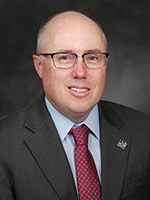
Dean of the College of Arts & Sciences Bradley Rundquist has also hosted regular virtual meetings with chairs, faculty and staff in what is UND’s largest college. Those events have served as sounding boards, shaping ideas and raising questions for Rundquist to present to the administration.
“On several occasions, a chair during a Council meeting or faculty and staff during an open meeting will ask, ‘What happens if …’ and my response is, ‘Great question, I hadn’t thought of that,’” Rundquist said. “I relay those questions to the interim provost and Pandemic Working Group, who discuss and work with me, chairs, and faculty on an answer or best practice.”
New solutions for teaching
Facing the challenges of delivering personalized or highly collaborative instruction in a remote fashion this fall, departments have come together to envision new ways of teaching that deliver excellence both online and in-person.
“I have said to the faculty, and the administration has said to them also, ‘What do you need,’” said Katherine Norman Dearden, chair of the Department of Music. “For example, sometimes we might be in class and sometimes we might not be. So the faculty has investigated new software that we can use to teach music notation and things like that online. We take those ideas to the powers-that-be and say, ‘Is this OK?’ And so far, they’ve said yes.”
Students in the Pride of the North marching band, for instance, will maintain a six-foot distance from one another during drills and follow specific protocols for uniform and instrument checkout, among other safety mandates. The department is still mulling the best kind of face coverings for wind-instrument musicians such as trumpeters and saxophone players.
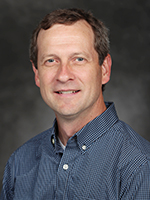
Theatre majors, meanwhile, may have to perform plays without live audiences, but faculty have geared up to allow “the show to go on” in an engaging manner that is also safe, Zerr said.
Furthermore, UND faculty members have worked hard to redesign schedules, especially for labs and hands-on educational experiences that usually lead to close interactions among students and their instructors.
Theatre set and costume design classes, for example, have been reworked so that each student operates a single tool a day without sharing with others.
“I have been impressed by the creativity of faculty and chairs in developing some really innovative approaches to these activities,” said Rundquist.
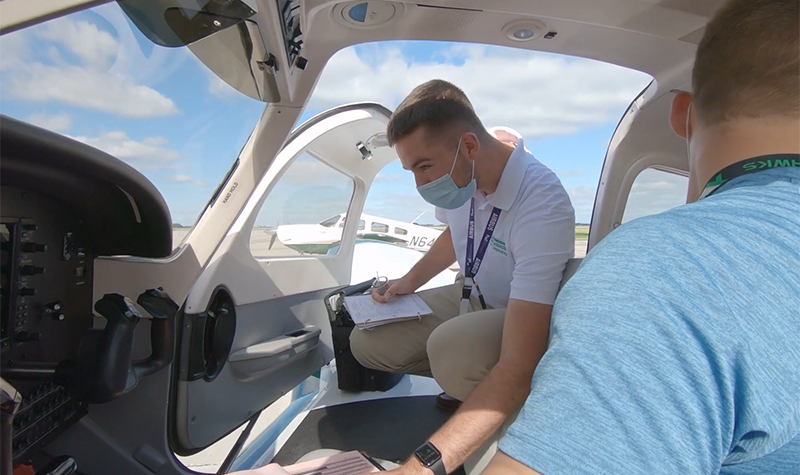
At the John D. Odegard School of Aerospace Sciences, faculty and other educators leading air traffic control labs, flight simulators and flight training have also adopted COVID-19 safety measures for those “really critical experiences for our students,” said Shayne Daku, assistant professor and assistant chair of the Department of Aviation.
“We use some of the knowledge that we gained from the flight operations process and apply it to the labs, once again working in concert with UND administration,” Daku said.
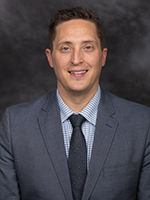
Preparing for a fall semester altered by COVID-19, Aerospace has gone a step further, surveying its students about their expectations and assembling a student focus group to help guide decisions.
At the School of Law, faculty will be implementing seat charts that will assign first-year on-campus students to a particular chair for as many classes as feasible. “Having a consistent seating chart for every student makes it easier to track attendance and for testing if necessary,” said McGinniss. “It limits their contacts.”
When it comes to personal safety, though, some faculty members have requested to wear face shields, the translucent plastic visors that cover one’s face, as an alternative to the required masks. The University administration has concurred, Storrs said, with face shields allowed only in the classroom and only for faculty. But because plastic guards do not seal the face as well as masks do, it is advisable to wear both a mask and a shield, as is the typical case in healthcare settings.
Given the physical distancing in the classrooms, the plexiglass used around desks, and because students will wear face coverings, donning both face masks and shields is not a requirement on campus. Yet, “if faculty are more comfortable wearing face shields, that’s what we’re going to support,” Storrs said.
That notion extends to the mode of instruction faculty may prefer. While a handful of studies and surveys show that students favor on-campus classes to their online alternatives (and some instructors also prefer in-person teaching), UND administrators are flexible in accommodating faculty members’ – as well as students’ – unique needs.
“If some faculty members feel they are at risk, they may be able to, of course, move to online,” VanLooy said. “These are decisions that ultimately are going to be made in the department. But we want to make sure that faculty do feel safe. There isn’t a one-size-fits-all solution for any of this.”
Rundquist echoed that assertion, saying that through discussions with department heads, A&S is putting faculty “in the driver’s seat” to effectively alter their courses in compliance with coronavirus restrictions and in accordance with their own health and safety concerns.
Concerns remain
And, there are concerns. A big one for Storrs is that the University cannot dictate students’ actions off-campus. She has heard from faculty who share that worry. Yet, what UND can do is proactively communicate with students about the dangers of COVID-19 and the best practices to avoid an infection, Storrs said. The University also will engage in regular testing, which will help identify any cases quickly and implement the needed measures to quarantine or isolate students, Storrs said.
VanLooy advised fellow faculty to heed the rules established to keep campus healthy and to stay abreast of the policies the Administration announces. He lauded the extensive efforts University leaders in various departments, offices and divisions have undertaken to engage with faculty. VanLooy further said that through monitoring faculty communication channels, University Senate officials are attentive to the apprehension that still exists among some faculty members.
“Whether or not they realize, we bring concerns forward to the pandemic planning groups and the Administration,” VanLooy said.
Despite all the preparation, uncertainty continues to permeate all aspects of life across the globe, prompting UND, like thousands of other higher-education institutions, to stay vigilant and consider contingencies. But McGinniss said, “The faculty have really risen to the occasion. We will be ready to greet students with strong offerings and be able to adapt as necessary. We are working hard to be flexible, make plans and adapt.”
Jan Orvik, Connor Murphy and Tom Dennis contributed to this report.


